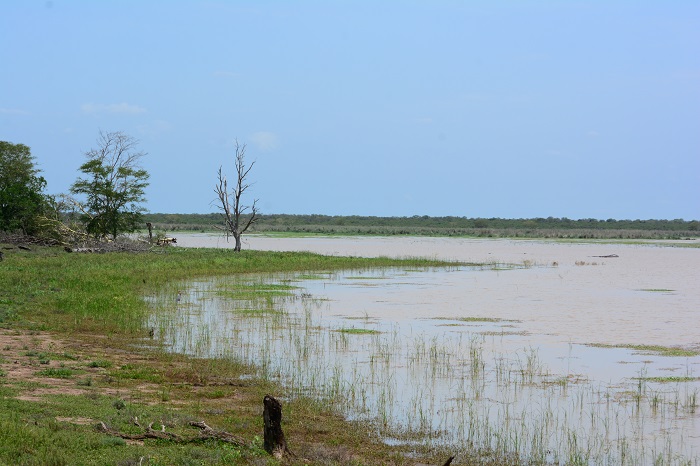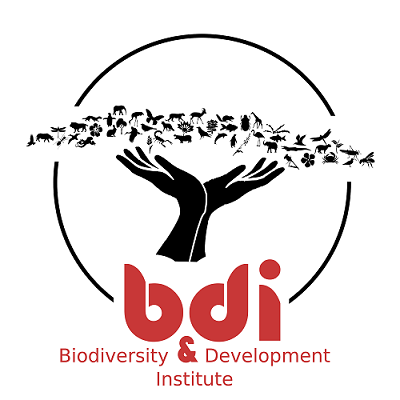Cover image: Three-banded Plover by Ansie Dee Reis – Dikhololo Resort, North West – BirdPix No. 265474
Identification
The Three-banded Plover is distinctive and easily recognisable, and is the only plover in the region with a double black breast band.

Stilbaai, Western Cape
Photo by Attie van Aarde
The undersides are white, broken only by the aforementioned double black breast bands on the upper breast and lower throat. The chin and throat is greyish-white and the remainder of the face and neck is greyish-brown. The upperparts and crown are dark greyish-brown. There is a white head-band stretching from the forehead and supercilium to meet on the lower hind neck. In flight the Three-banded Plover is seen to have white underwings and a wedge-shaped tail.
The bill is coral-red with a black tip. The eyes are yellow-brown with a red eye ring and the legs and feet are reddish-pink. The sexes are alike.

Rondevlei, Western Cape
Photo by Andre Kok
Juveniles resemble adults but are duller and the feathers on the upper parts and breast bands are edged in pale brown and they have less distinct facial markings. They also have duller, more orange coloured legs and eye-rings.

Karoo Gariep Nature Reserve, Northern Cape
Photo by Josu Meléndez
Status and Distribution
The Three-banded Plover is a common to very common resident and local migrant.
It is widespread across sub-Saharan Africa, ranging almost continuously from Ethiopia across to Gabon and down to South Africa and is also widespread on Madagascar. It is found throughout southern Africa except the very driest parts of Botswana, Namibia and the Northern Cape. It is scarce in high mountainous and heavily wooded or forested regions, but is liable to turn up almost anywhere there is suitable habitat.

The Three-banded Plover has expanded its distribution greatly since the advent of dam building throughout Southern Africa. Previously its range would have been notably more fragmented. The Three-banded Plover has a healthy conservation status and is not threatened.
Habitat

Photo by Ryan Tippett
The Three-banded Plover occurs in the widest range of aquatic habitats of any wader in Southern Africa. It makes extensive use of artificial waterbodies, especially farm dams and even visits puddles formed by leaking pipes in arid areas. Its choice of wetland habitat is almost independent of vegetation type.
It is frequent along the open mud or sand shores of any freshwater habitat, favouring pools, streams and seeps, as well as sandbanks along larger rivers, farm dams and sewage works. It is sometimes found along the coast where it visits rock and tidal pools, estuaries and lagoons, but is rare along open coastlines.

Photo by Ryan Tippett
Behaviour
The Three-banded Plover is typically encountered singly, in pairs, or in groups of up to 10 or so birds. It is less gregarious than other small plovers but occurs in loose flocks of varying sizes when not breeding. It is found in pairs during the breeding season.

Kruger National Park, Limpopo
Photo by Richard Johnstone
Three-banded Plovers are partial intra-African migrants in response to seasonal rainfall but its movements are poorly understood. It is largely sedentary in areas of higher rainfall.
The Three-banded Plover bobs its head and body up and down when disturbed. It is alert but is often fairly confiding. The flight is rocking and erratic and it raises and lowers its tail repeatedly upon landing.

Carnarvon district, Northern Cape
Photo by Ryan Tippett
They are active both day and night, foraging with the typical plover ‘stop-start’ running action. Prey is located visually and pecked from the substrate. The Three-banded Plover consumes a variety of terrestrial and aquatic invertebrates, including insects, crustaceans, small molluscs and worms.

Langebaan district, Western Cape
Photo by Graham Bull
Breeding occurs in southern Africa throughout the year. At the onset of the breeding season males perform courtship displays with the breast touching the ground and the tail raised and sometimes fanned.
Three-banded Plovers are monogamous, territorial and solitary nesters and territories are maintained throughout the breeding cycle. Breeding territories are established along 80-150 m of shoreline and are defended from rivals by flying or running at conspecifics with a crouched posture, and with flank feathers fluffed out, frequently while emitting a rattling call.

Welkom district, Free State
Photo by Janet du Plooy
The nest is a simple scrape in the substrate and is usually situated close to water. Nests are lined with bits of vegetation, dried mud or pebbles. 1 to 2 (rarely 3) eggs are laid per clutch and are laid at 1 or 2 day intervals. Incubation likely begins once the final egg has been laid and incubation duties are shared by both sexes. Females incubate the eggs during the day, whilst males spend their days defending the territory. Males then take their turn to incubate at night, when females head off to feed. The incubating bird sits tight, sometimes allowing intruder to within 3 m before running away.
On hot days the incubating female sometimes crouches over the eggs and occasionally soaks her belly feathers with water to cool down the eggs.

Kruger National Park, Limpopo
Photo by Terry Terblanche
Newly hatched young are precocial and covered in down. They are brooded frequently by both parents, usually in response to intruders, rain or low temperatures. The adults Parent crouch up and down to encourage chicks to be brooded. The young are fully fledged at around 31 days, but may remain with their parents for a further 10 days or so.
Three-banded Plovers are often double, or sometimes even triple-brooded, meaning they attempt to breed more than once during the breeding season. Female are sometimes known to lay a second clutch well before the first brood is fully fledged.

Hoedspruit district, Limpopo
Photo by Neels Putter
Further Resources
Species text from the first Southern African Bird Atlas Project (SABAP1), 1997.
The use of photographs by Andre Kok, Ansie Dee Reis, Attie van Aarde, Graham Bull, Janet du Plooy, Josu Meléndez, Karis Daniel, Neels Putter, Richard Johnstone and Terry Terblanche is acknowledged.
Virtual Museum (BirdPix > Search VM > By Scientific or Common Name).
Other common names: Driebandstrandkiewiet (Afrikaans); Inqatha (Xhosa); N’wantshekutsheku, Xitsekutseku (Tswana); Driebandplevier (Dutch); Pluvier à triple collier (French); Dreiband-Regenpfeifer (German); Borrelho-de-três-golas (Portuguese)
A list of bird species in this format is available here.
Recommended citation format: Tippett RM 2023. Three-banded Plover Charadrius tricollaris. Biodiversity and Development Institute. Available Online at https://thebdi.org/2023/11/14/three-banded-plover-charadrius-tricollaris/

Near Clanwilliam, Western Cape
Photo by Karis Daniel

